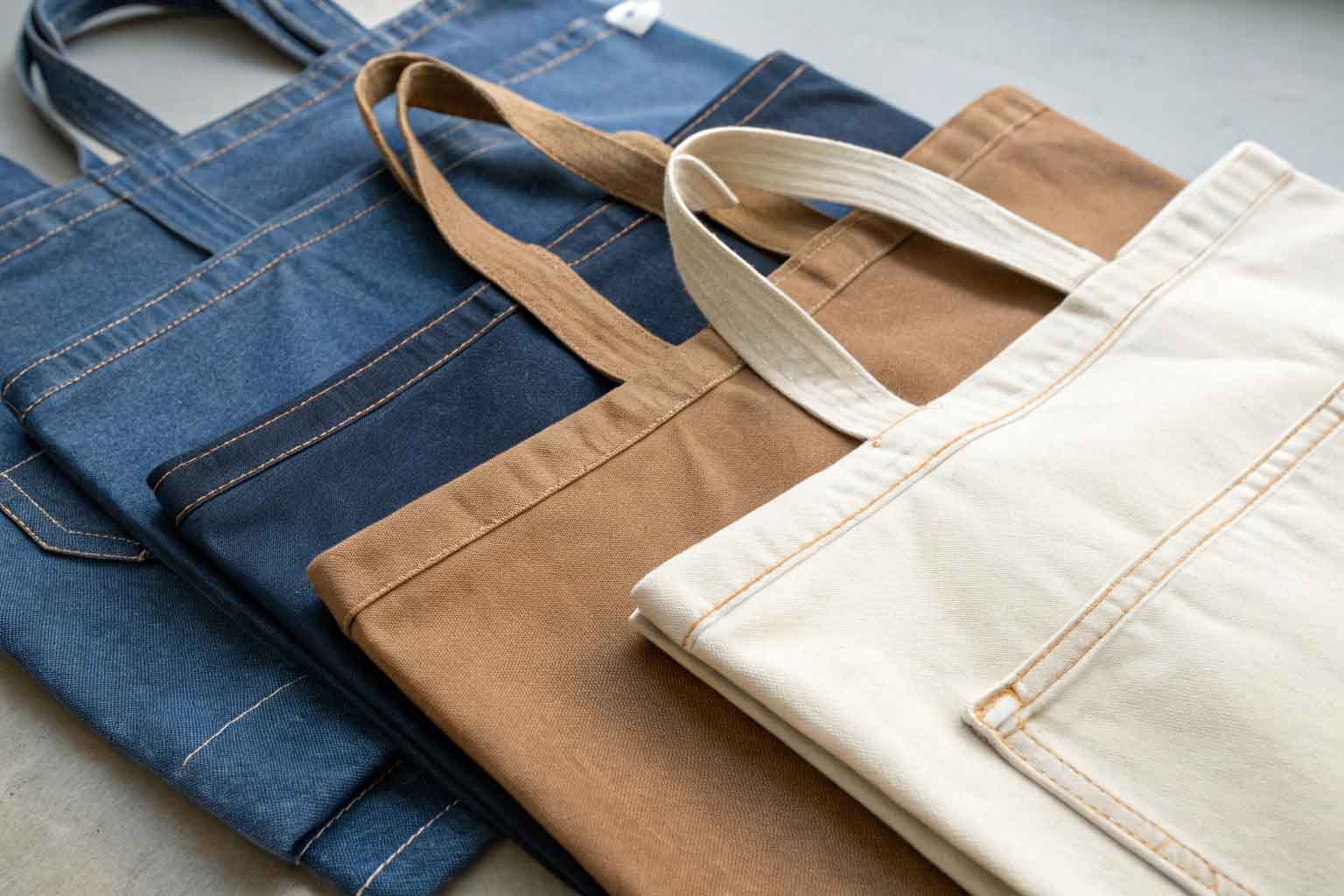State pianificando un ordine di tote bag ma non siete sicuri di quanta stoffa vi servirà? Le supposizioni sbagliate comportano uno spreco di materiali e di denaro. Lasciate che vi aiuti a stimare con precisione.
Per una tipica borsa tote (circa 12-16 pollici quadrati), prevedete circa 1 iarda di tessuto di larghezza standard. Per borse più piccole e semplici potrebbe bastare 1/2 iarda. Questo vi dà un punto di partenza sicuro prima di considerare i dettagli specifici del design.

Ottenere la quantità giusta è fondamentale per una produzione regolare e per il controllo dei costi. Ma "tipico" può significare diverse cose e diversi fattori modificano il numero finale. Vediamo di analizzare meglio la questione, in modo da poter affrontare l'approvvigionamento con fiducia.
Qual è la dimensione tipica di una borsa Tote?
Il termine "tote standard" vi sembra vago quando pianificate il vostro progetto? Le diverse dimensioni hanno un impatto significativo sul fabbisogno di materiale. Vediamo le dimensioni più comuni.
La maggior parte delle borse standard ha una larghezza compresa tra 12 e 16 pollici e un'altezza tra 12 e 18 pollici. La profondità, o soffietto, varia solitamente da 4 a 10 pollici. Conoscere questi dati aiuta a visualizzare le proprie esigenze.

Capire le dimensioni comuni delle tote
Quando parlo di tote bag con i clienti, l'idea di "standard" varia. Una borsa piccola potrebbe essere perfetta per un omaggio promozionalecirca 12 pollici di larghezza per 14 pollici di altezza con un piccolo soffietto di 3 pollici. Una misura media, forse 15×15 pollici con un soffietto di 5 pollici, è molto popolare per l'uso generale - si pensi alle borse per eventi o alle semplici borse per la vendita al dettaglio. Borse più grandi, come quelle da 18 pollici di larghezza, 16 pollici di altezza e con un generoso soffietto da 8 pollici, funzionano bene per la spesa o per le gite in spiaggia.
Come le dimensioni si rapportano all'uso
L'uso previsto influenza fortemente le dimensioni ideali. Una borsa leggera per trasportare documenti a una conferenza non ha bisogno del volume di una robusta borsa per la spesa settimanale. Spesso vedo clienti che partono da un'idea "standard", ma capire le loro esigenze specifiche aiuta a definire la dimensione perfetta e funzionale. Pensate a ciò che l'utente finale dovrà trasportare: questo chiarisce se è meglio un ingombro piccolo, medio o grande.
Guida rapida alla stima del tessuto per taglia
Per darvi un punto di partenza più chiaro, ecco una stima approssimativa della stoffa necessaria per le dimensioni più comuni delle tote bag, in base alle misure da voi fornite. Ricordate che si tratta di borse semplici, sfoderate, realizzate con tessuti standard da 44/45 pollici di larghezza, compresi i manici di base, ma senza tasche complesse o modelli coordinati.
| Categoria di dimensioni | Dimensioni (L x A x P pollici) | Tessuto stimato necessario (larghezza 44/45") |
|---|---|---|
| Piccolo | 12 x 14 x 4 | ~ 1 metro |
| Medio | 14 x 16 x 5 | ~ 1,25 metri |
| Grande | 15 x 18 x 8 | ~ 1,5 metri |
| Extra Large | 17 x 20 x 10 | ~ 1,75 metri |
Nota: queste sono stime di base. Fodere, tasche, maniglie complesse, tessuti di larghezza inferiore e abbinamenti di modelli aumentano notevolmente la quantità necessaria.
La comprensione di questi intervalli tipici vi aiuta a comunicare meglio le vostre esigenze al momento dell'approvvigionamento e vi fornisce un'indicazione di massima per le stime iniziali dei tessuti.
Quali fattori influenzano la quantità di tessuto?
Pensate che le dimensioni siano l'unica cosa che influisce sulle esigenze del tessuto? Altre scelte di design possono sommarsi silenziosamente. Scopriamo questi consumatori nascosti di tessuto.
Oltre alle dimensioni di base, bisogna considerare la fodera (raddoppia il tessuto!), le tasche (aggiungono 10-20%+), la larghezza del tessuto (più stretto richiede più lunghezza), l'abbinamento al modello (possono essere necessarie fino a 50% in più!) e i dettagli di costruzione come gli angoli inscatolati o i soffietti. Ognuno di questi elementi influisce sulla lunghezza finale del tessuto.

L'impatto del rivestimento
L'aggiunta di una fodera eleva immediatamente una tote bag, conferendole un aspetto rifinito e una maggiore resistenza. Ma ricordate che si tratta essenzialmente di una seconda borsa cucita all'interno della prima. Ciò significa che avrete bisogno di una quantità di tessuto circa doppia rispetto a una borsa non foderata: un metro per l'esterno e un altro metro per la fodera, assumendo larghezze di tessuto simili. Si tratta di un fattore significativo per il costo del materiale.
Tasche: All'interno e all'esterno
Le tasche aggiungono una grande funzionalità, ma richiedono un tessuto supplementare. Una tasca interna può richiedere solo un piccolo quadrato aggiuntivo, forse 8×8 pollici. Ma l'aggiunta di più tasche, o di tasche esterne di grandi dimensioni come quelle delle borse multiuso, può aumentare il fabbisogno di tessuto da 10% a 20% o anche di più. Ricordo che un cliente voleva sei tasche esterne di grandi dimensioni; abbiamo dovuto calcolare attentamente la metratura extra necessaria, facendo lievitare il preventivo iniziale.
La larghezza del tessuto è importante
La stoffa è generalmente disponibile in larghezze standard, spesso 44/45 pollici, oppure in larghezze maggiori, come 54 o 60 pollici. Se si utilizza un tessuto più stretto, potrebbe essere necessaria una lunghezza maggiore (yardage) per tagliare tutti i pezzi necessari, rispetto a un tessuto più largo che consente di affiancare i pezzi del cartamodello in modo più efficiente. Verificate sempre la larghezza utilizzabile del tessuto scelto.
Sfide di pattern matching
L'utilizzo di tessuti a righe, a quadri o con stampe di grandi dimensioni richiede un'attenta corrispondenza dei modelli per ottenere un aspetto professionale. Ciò significa che non si possono tagliare i pezzi dove capita, ma è necessario allineare il modello alle cuciture. Questo comporta spesso un notevole spreco di tessuto, che a volte richiede fino a 50% di yard in più rispetto a una tinta unita o a una stampa casuale.
Dettagli costruttivi: Tasselli e angoli squadrati
La profondità di una tote bag, creata da un soffietto (un pezzo separato per il fondo e i lati) o da angoli squadrati (taglio di quadrati dagli angoli inferiori e cucitura), influisce direttamente sulle dimensioni dei pannelli principali di tessuto necessari. Una borsa più profonda richiede pannelli principali più larghi o più lunghi per adattarsi alla profondità. Questo aspetto viene calcolato nel calcolo iniziale, ma è importante ricordarlo.
Riepilogo rapido: Fattori che aumentano il fabbisogno di tessuto
| Fattore | Aumento stimato del tessuto necessario | Note |
|---|---|---|
| Fodera | ~100% (raddoppia il tessuto) | Richiede materiale per una borsa interna. |
| Tasche | 10% - 20%+ | Dipende dalle dimensioni e dal numero di tasche. |
| Corrispondenza dei modelli | Fino a 50% | Per allineare righe, plaid, stampe di grandi dimensioni. |
| Tessuto stretto | Variabile | Richiede una lunghezza maggiore per adattarsi ai pezzi. |
| Tasselli complessi | Piccolo aumento | Possono essere necessari pezzi separati più larghi. |
Come si calcola il fabbisogno di tessuto?
Siete pronti ad andare oltre le stime? Un calcolo accurato dei tessuti evita costose carenze o ordini eccessivi. Vediamo un metodo semplice.
Calcolare separatamente la stoffa per i pannelli principali (fronte/retro/ fondo, se possibile), le maniglie e le eventuali tasche. Aggiungete i margini di cucitura (di solito 1/2 pollice per cucitura) e i margini di orlo (1-2 pollici). Somma questi pezzi, tenendo conto della larghezza del tessuto per disporli in modo efficiente.

Scomposizione dei componenti della borsa
Per calcolare il tessuto necessario, pensate alla tote bag come a parti separate:
- Corpo principale: Di solito è il pezzo più grande. A volte si tratta di un pezzo continuo (fronte + fondo + retro), oppure di due pezzi separati (fronte/retro) più un pezzo inferiore.
- Maniglie: Tipicamente strisce lunghe e strette. Ne occorrono due.
- Tasche: Calcolare il tessuto per ogni tasca separatamente.
- Fodera: Se è foderata, calcolatela come una seconda borsa (corpo principale, eventualmente tasche).
Esempio di calcolo passo-passo
Utilizziamo l'esempio più chiaro: una tote bag alta 12 pollici, larga 12 pollici e profonda 10 pollici (una forma squadrata).
- Corpo principale: Un modo comune è un unico pezzo che copre la parte anteriore, inferiore e posteriore.
- Lunghezza necessaria: (altezza della borsa + orlo superiore/finitura) + profondità del fondo + (altezza della borsa + orlo superiore/finitura). Ipotizziamo una finitura di 1 pollice nella parte superiore. Quindi, (12" + 1") + 10" + (12" + 1") = 13" + 10" + 13" = 36 pollici di lunghezza.
- Larghezza necessaria: Larghezza della borsa + profondità della borsa + margini di cucitura (usiamo 1/2" per lato, quindi 1" in totale). Quindi, 12" + 10" + 1" = 23 pollici di larghezza.
- Avreste bisogno di un pezzo principale di circa 36 pollici di lunghezza x 23 di larghezza. (Nota: 36 pollici corrispondono a 1 iarda).
- Questo calcolo mostra come la profondità influisca significativamente sulla larghezza necessaria per questo stile di costruzione. Per una larghezza di tessuto standard di 44/45 pollici, questo pezzo si adatta comodamente.
Non dimenticate le maniglie e le tasche!
Le maniglie possono essere tagliate in due strisce, ad esempio di 4 pollici di larghezza per 24 pollici di lunghezza ciascuna. Le tasche devono essere calcolate nelle loro dimensioni, compresi i margini di cucitura e l'eventuale orlo superiore. Aggiungete l'area di tutti questi pezzi extra al totale. Per esempio, due maniglie da 4×24 pollici richiedono un pezzo di tessuto di almeno 8 x 24 pollici o 4 x 48 pollici.
Stesura su tessuto e aggiunta di un cuscinetto
Una volta conosciute le dimensioni di ogni pezzo, visualizzate come si adattano alla larghezza del tessuto. È possibile tagliare le maniglie accanto al pezzo principale del corpo? Una disposizione efficiente riduce al minimo gli scarti. Infine, consiglio sempre di aggiungere un piccolo cuscinetto, magari 10% di tessuto in più, in caso di errori di taglio o problemi imprevisti. È meglio avere un po' di tessuto in più che rimanere a corto.
Qual è il tipo di tessuto migliore per le borse?
La scelta del materiale giusto è fondamentale per l'aspetto e la durata di una tote. L'uso di un tessuto fragile porta alla delusione. Esploriamo le opzioni più resistenti.
Per borse robuste e durature, scegliete tessuti resistenti come la tela di cotone, il tessuto di anatra, il denim o il drill di cotone pesante. Considerate lo scopo della borsa: tessuti più pesanti per le borse della spesa, più leggeri (ma comunque resistenti) per le borse promozionali. La fodera aggiunge struttura e finitura.

Caratteristiche principali del tessuto
Quando scelgo il tessuto per le tote bag, soprattutto per esigenze di lavoro, mi concentro su alcuni aspetti fondamentali:
- Durata: Il tessuto deve resistere al peso e all'uso regolare. Cercate materiali a trama fitta.
- Peso/struttura: Il tessuto ha abbastanza corpo per mantenere la forma o sarà floscio? I pesi più pesanti (come la tela da 10 o 12 once) offrono una maggiore struttura.
- Stampabilità: Se si tratta di borse di marca, il tessuto deve accettare stampare bene. Le fibre naturali, come la tela di cotone, sono di solito eccellenti per questo scopo.
- Lavabilità: Considerate se l'utente finale dovrà lavare la borsa. Il cotone è generalmente lavabile, ma è bene verificare che non si restringa.
- Sostenibilità: Sempre più clienti chiedono opzioni ecologiche come il cotone organico, la juta o il RPET.
I tessuti più diffusi per le borse Tote: Pro e contro
Ecco un rapido confronto dei materiali comunemente utilizzati:
| Tessuto | Pro | Contro | Il migliore per |
|---|---|---|---|
| Cotone | Naturale, traspirante, morbido, buona stampabilità, versatile | Può sgualcirsi/restringersi, è meno durevole della tela. | Uso generale, borse più leggere, promozioni, omaggi |
| Tela (cotone) | Molto durevole, robusto, mantiene bene la forma, ottima superficie di stampa | Può essere pesante, più rigido, può restringersi se non viene prelavato. | Borse per carichi pesanti, generi alimentari, borse per libri, vendita al dettaglio |
| Juta | Ecologico, resistente, dalla consistenza unica, conveniente | Ruvida al tatto, può disperdere le fibre, difficile per le stampe fini | Borse eco-consapevoli, look rustico, borse per la spesa |
| Denim | Forte, durevole, elegante, ampiamente disponibile | Pesante, potenziale emorragia da tintura, può essere costoso | Tote alla moda, borse casual, articoli promozionali durevoli |
| Nylon | Leggero, robusto, resistente all'acqua, durevole | Sensazione sintetica, meno traspirante, preoccupazione per l'ambiente | Borse pieghevoli, viaggio, sport, protezione dalla pioggia |
| RPET | Ecologico (plastica riciclata), durevole, resistente all'acqua | Può avere una sensazione di plastica, la qualità varia | Eco-promozioni, borse per la spesa riutilizzabili, eventi |
| Pelle | Aspetto/sensibilità premium, molto resistente, sviluppa la patina | Costoso, pesante, richiede cure, preoccupazioni etiche | Vendita al dettaglio di alta gamma, regali aziendali di lusso |
Caratteristiche del tessuto in sintesi
Questa tabella fornisce un altro modo per confrontare le scelte più comuni:
| Caratteristica | Cotone | Tela | Juta | Denim | Nylon | RPET | Pelle |
|---|---|---|---|---|---|---|---|
| Durata | Medio | Alto | Alto | Alto | Alto | Medio-alto | Molto alto |
| Peso | Luce-Med | Medio-pesante | Medio | Pesante | Luce | Luce-Med | Pesante |
| Stampabilità | Buono | Eccellente | Fiera | Buono | Buono (con trattamento) | Buono | Difficile (meglio goffrare/rilasciare) |
| Resistenza all'acqua | Basso | Basso (se non trattato) | Basso | Basso | Alto | Alto | Alto (se trattato) |
| Ecologico | Med (Biologico=Alto) | Med (Biologico=Alto) | Alto | Med | Basso | Alto | Low-Med (dipende dall'abbronzatura) |
Abbinare il tessuto allo scopo
In definitiva, il tessuto migliore dipende dall'uso previsto per la borsa e dall'immagine del vostro marchio. Per gli articoli ad alto utilizzo, come le borse della spesa, la durata è fondamentale: scegliete la tela o il juet. Per un omaggio promozionale in cui il budget è fondamentale, potrebbero essere sufficienti il cotone o il RPET. Per un regalo di qualità si può prendere in considerazione la pelle. Consiglio sempre ai clienti di procurarsi dei campioni: sentire il peso e la consistenza del tessuto fa una grande differenza sulla qualità percepita e sulla funzionalità.
Conclusione
Quindi, anche se le stime sono utili, calcolate sempre in base alle dimensioni esatte, alla fodera, alle tasche e alla scelta del tessuto. Una pianificazione accurata vi garantisce di ottenere borse perfette senza sprechi.


